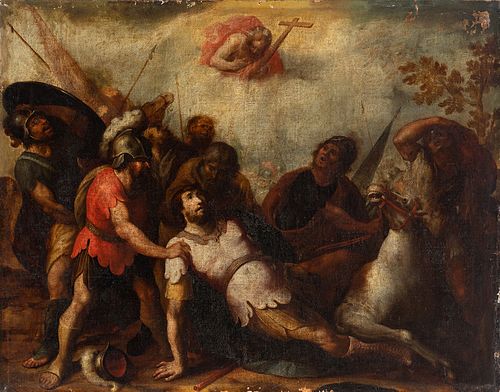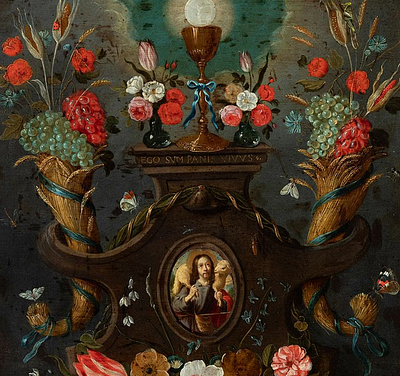Andalusian school; second half of the 17th century. "San Pablo's fall". Oil on canvas. Re-retouched.
Lot 18
About Seller
Setdart Auction House
Carrer Aragó 346
Barcelona
Spain
Setdart Subastas was born in 2004 and is currently the first online art auction in Spain with solidity, prestige and reliability guaranteed by our more than 60,000 users. Setdart has a young, dynamic and enterprising team ready to successfully manage the purchase and sale of art works through custom...Read more
Estimate:
EUR€1,800 - EUR€2,000
$1,894.74 - $2,105.26
Absentee vs Live bid
Two ways to bid:
- Leave a max absentee bid and the platform will bid on your behalf up to your maximum bid during the live auction.
- Bid live during the auction and your bids will be submitted real-time to the auctioneer.
Bid Increments
| Price | Bid Increment |
|---|---|
| EUR€0 | EUR€10 |
| EUR€200 | EUR€25 |
| EUR€500 | EUR€50 |
| EUR€1,000 | EUR€100 |
| EUR€3,000 | EUR€200 |
| EUR€5,000 | EUR€500 |
| EUR€10,000 | EUR€1,000 |
| EUR€20,000 | EUR€2,000 |
| EUR€50,000 | EUR€5,000 |
About Auction
By Setdart Auction House
Sep 21, 2021
Set Reminder
2021-09-21 10:00:00
2021-09-21 10:00:00
America/New_York
Bidsquare
Bidsquare : 21st September - ARAS JÁUREGUI Private Collection - Old Masters, 19th & 20th Century
https://www.bidsquare.com/auctions/setdart-auction-house/21st-september---aras-j-uregui-private-collection---old-masters-19th-20th-century-7429
Setdart Auction House sofia@setdart.com
Setdart Auction House sofia@setdart.com
- Lot Description
Andalusian school; second half of the 17th century. "San Pablo's fall". Oil on canvas. Re-retouched. The canvas is detached from the stretcher and has some faults. Measurements: 82,5 x 102,5 cm. In this work we see the traditional representation of the conversion of St. Paul, with the saint who has already fallen from his horse, in an interesting scenographic representation, populated by a multitude of characters, who surround the main figure of the saint. All of them are placed in the foreground, in the manner of a frieze, although the central position of Saint Paul, together with the clarity of his clothing, completely directs the viewer's gaze. The work is completed by a celestial plane, in the centre of which the presence of Jesus Christ with the cross can be seen, attentively observing the scene. Paul was a Hellenised Jew from the Diaspora, born in Tarsus. He was therefore Jewish by ethnicity, Greek by culture and Roman by nationality. He received the name Saul, which he changed to Paul after his conversion. Born at the beginning of the first century, he studied in Jerusalem under the rabbi Gamaliel, who would have been noted for his hatred of Christians. One day, when he was on his way from Jerusalem to Damascus around the year 35, he was dazzled by lightning and fell from his horse. Then he heard the voice of Jesus saying to him: "Saul, Saul, why are you persecuting me? As a result of this experience, the saint changed abruptly from persecutor to zealot of Christianity. The 17th century saw the arrival of the Baroque in the Andalusian school, with the triumph of naturalism over Mannerist idealism, a loose style and many other aesthetic liberties. At this time the school reached its greatest splendour, both in terms of the quality of its works and the primordial status of Sevillian Baroque painting. Thus, during the transition to the Baroque period, we find Juan del Castillo, Antonio Mohedano and Francisco Herrera el Viejo, whose works already display the rapid brushstrokes and crude realism of the style, and Juan de Roelas, who introduced Venetian colourism. The middle of the century saw the fullness of the period, with figures such as Zurbarán, a young Alonso Cano and Velázquez. Finally, in the last third of the century we find Murillo and Valdés Leal, founders in 1660 of an Academy where many of the painters active during the first quarter of the 18th century were trained, such as Meneses Osorio, Sebastián Gómez and Lucas Valdés, among others.
- Shipping Info
-
In-house shipping available. Please inquire at admin@setdart.com.
-
- Buyer's Premium



 EUR
EUR CAD
CAD AUD
AUD GBP
GBP MXN
MXN HKD
HKD CNY
CNY MYR
MYR SEK
SEK SGD
SGD CHF
CHF THB
THB

















